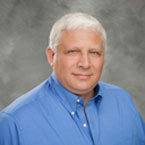 In this brief series on 3D laminating press distinctions we’ve covered the liquid filled membrane press, called a bladder press, and membrane-less presses. Today’s feature is the membrane press.
In this brief series on 3D laminating press distinctions we’ve covered the liquid filled membrane press, called a bladder press, and membrane-less presses. Today’s feature is the membrane press.
To be fair, three different types of 3D laminating systems use silicone or natural rubber membranes. (See 3D Laminating Glossary) In addition to bladder presses, vacuum formers will often have an option to include a membrane as well, but we’ll cover them in more detail next week. But when experienced professionals in the industry talk about a membrane press they are usually referring to a system that generates positive pressure over the 3D laminate (3DL) by inflating a membrane with compressed air.
The diagram below shows a pressing chamber that is typical of nearly all major membrane press manufacturers in recent years. This system incorporates three separate pressure chambers that are needed for a cycle:
 1. As the press closes, the preheat cycle is accomplished by introducing vacuum through the separation frame that is sandwiched between the 3DL and the membrane. When the two come in contact heat is transferred from the membrane into the 3DL.
1. As the press closes, the preheat cycle is accomplished by introducing vacuum through the separation frame that is sandwiched between the 3DL and the membrane. When the two come in contact heat is transferred from the membrane into the 3DL.
2. After the 3DL has taken in enough heat to form to the substrate and activate the adhesive, vacuum is then introduced into the lower chamber. Vacuum is maintained in the center as well assuring that the membrane will be drawn down with the 3DL. The importance of this step will be covered shortly.
3. Positive air pressure typically ranging from 45 to 75 psi is then introduced into the chamber above the membrane to force the softened 3DL into detailed profiles and provide additional bond strength along the edges.
4. In the final step, air pressure is released from above the membrane but introduced into the middle chamber. This cold compressed air serves to separate the membrane and 3DL, as well as cool the 3DL and adhesive so pressure can safely be released.
What’s in a Frame?
To say the least, the separation frame that creates the middle chamber has been the source of controversy for many years as this technology was the subject of various U.S. and international patents assigned to Wemhoner. The importance of this frame can be demonstrated by how quickly other manufacturers used this technology once the U.S. patent expired. Today, nearly every press manufacturer active in the North American market incorporates some version of this frame.
The benefits of this technology are immense. The ability to vacuum the 3DL and membrane together even while the laminate is vacuumed down around the substrate accomplishes two important tasks: keeping heat to the 3DL longer for better adhesive activation, and preventing folds from forming on corners of parts regardless of spacing. Both benefits impact product quality. The elimination of spacing concerns is also a huge boost to production capacity.
The middle chamber also provides a means to separate the membrane from the 3DL while keeping the finished product under pressure and cooling both laminate and adhesive. Though few are left on the market today, membrane presses that have no means of cooling under pressure often struggle with laminate sticking to the membrane as the press opens as well as pulling away from the substrate due to the adhesive still being soft.
Although it is true that every press technology presented in this series has its place, there is no doubt that the three-chamber membrane press has become the system of choice for high production. It offers the greatest flexibility of part spacing, the most security in reaching adhesive activation temperatures, and many other options that are too detailed for this blog. The middle chamber allows the operator to have the best of both worlds: the security that a membrane provides, but the ability to get the high definition of a membrane-less press by increasing the cooling pressure at the end of the cycle.
Next week we’ll take a closer look at using a vacuum former as a 3D laminating system. It has its place, but the industry desperately needs to understand its limitations.






Have something to say? Share your thoughts with us in the comments below.